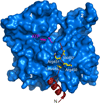Actin filament nucleation and elongation factors--structure-function relationships
- PMID: 19874150
- PMCID: PMC2787778
- DOI: 10.3109/10409230903277340
Actin filament nucleation and elongation factors--structure-function relationships
Abstract
The spontaneous and unregulated polymerization of actin filaments is inhibited in cells by actin monomer-binding proteins such as profilin and Tbeta4. Eukaryotic cells and certain pathogens use filament nucleators to stabilize actin polymerization nuclei, whose formation is rate-limiting. Known filament nucleators include the Arp2/3 complex and its large family of nucleation promoting factors (NPFs), formins, Spire, Cobl, VopL/VopF, TARP and Lmod. These molecules control the time and location for polymerization, and additionally influence the structures of the actin networks that they generate. Filament nucleators are generally unrelated, but with the exception of formins they all use the WASP-Homology 2 domain (WH2 or W), a small and versatile actin-binding motif, for interaction with actin. A common architecture, found in Spire, Cobl and VopL/VopF, consists of tandem W domains that bind three to four actin subunits to form a nucleus. Structural considerations suggest that NPFs-Arp2/3 complex can also be viewed as a specialized form of tandem W-based nucleator. Formins are unique in that they use the formin-homology 2 (FH2) domain for interaction with actin and promote not only nucleation, but also processive barbed end elongation. In contrast, the elongation function among W-based nucleators has been "outsourced" to a dedicated family of proteins, Eva/VASP, which are related to WASP-family NPFs.
Figures







References
-
- Auerbuch V, Loureiro JJ, Gertler FB, Theriot JA, Portnoy DA. Ena/VASP proteins contribute to Listeria monocytogenes pathogenesis by controlling temporal and spatial persistence of bacterial actin-based motility. Mol Microbiol. 2003;49:1361–1375. - PubMed
-
- Bachmann C, Fischer L, Walter U, Reinhard M. The EVH2 domain of the vasodilator-stimulated phosphoprotein mediates tetramerization, F-actin binding, and actin bundle formation. J Biol Chem. 1999;274:23549–23557. - PubMed
Publication types
MeSH terms
Substances
Grants and funding
LinkOut - more resources
Full Text Sources
